Authored by Negussie F Bussa*,
Introduction
Among the major classes of microbial enzymes contributing immediate application are the hydrolytic enzymes [1], which account approximately 75% of the industrial enzymes produced. Through the use of hydrolytic enzymes many different natural and agricultural polymers such as starch was processed and up graded for eventual human or animal consumption, or for further bioconversion into value added products.
Starch degrading enzymes called amylases have received a great deal of attention because of their perceived technological significance and economic benefits. Amylases have got increasing demand and potential application in a wide number of industrial processes. This is because of the enormous interest in developing enzymes with better properties such as raw starch degrading amylases suitable for industrial applications and their cost-effective production techniques [2].
Amylase enzymes make use of starch and related oligo and polysaccharides to cleave glycosidic bonds either from the nonreducing end (exo-acting enzymes) or in the interior (endo-acting enzymes) of the polymer. These enzymes have useful applications in the brewing, textile, paper, detergent, and pharmaceutical industries. They are also used in the production of maltose, oligosaccharide mixtures, and high fructose and maltotetraose syrup industries [3]. Furthermore, the application of amylase expanded in many fields such as clinical, medicinal and analytical chemistry [4]. The three best known amylases are α-amylase, β-amylase and glucoamylase that can be produced from fungi, yeasts, bacteria, plants and animals which are among the most important enzymes in present day biotechnology [5].
The amylases produced by microorganisms have a broad spectrum of industrial applications as they are more stable than plant and animal amylases. The major advantage of using microorganisms for the production of amylases is the economical bulk production capacity and the fact that microbes are easy to manipulate to obtain enzymes of desired characteristics [6]. Microbial amylase can be produced by submerged as well as solid state fermentations. Solid state fermentation holds tremendous potentials for the production of amylase. It can be of special interest in those processes where the crude fermented product may be used directly as the source of amylase. This method has economic value for countries with abundance of biomass and agro industrial residues, as these can be used as cheap raw materials.
However, the growth of microorganism and the resulted amylase are strongly influenced by medium composition. Thus, optimization of media components and cultural parameters is the primary task in a biological process in order to obtain a good result in amylase production. Therefore, to meet the growing demands for these enzymes in various industries, it is necessary to improve the performance of the system so as to increase the yield without increasing the cost of production especially in developing countries like Ethiopia [7].
In Ethiopia, most of its economy is dependent on agriculture, which makes it beneficiary from starch and starch products. In this regard, industries that utilize starch and other agricultural raw materials to provide quality products use large quantities of amylases which have a considerable economic significance. For this reason, the development of starch-based industries is crucial to address the demand of the current society. But this requires the presence of promising starch hydrolyzing amylase from microorganisms that enable to degrade a variety of agricultural products efficiently [8].
In spite of the above facts, insufficient work was carried out in the production and characterization of fungal starch degrading amylases from environmental sources in Ethiopia. In order to fill some of these gaps of research, the study was aimed and designed to isolate, screen and characterize amylase from soil inhabiting microbial sources, such as fungal strains from forest soils.
Materials and Methods
Description of the study area
The study was conducted at Addis Ababa University, Science Faculty Centre for Food Science and Nutrition Program. Samples were taken from Wof Washa Forest (WWF) located at 9°44′32″- 9°46′26″N and 39°44′00″-39°47′19″E in North Shoa, Ethiopia. The altitude of the study area ranged from 1700 to 3910 m above sea levels and the temperature ranged from a mean annual minimum of 10° C at Kundi peak in Ankober to a mean annual maximum of 20° C at lower altitudes. The forest area stretched from Southeast to Northwest along the rift valley escarpment on its eastern part. It divided the Awash and Nile basins on its western part and covers 78 km2 Figure 1. The soils could be categorized based on their colours as black, brown and red (Figure 1).
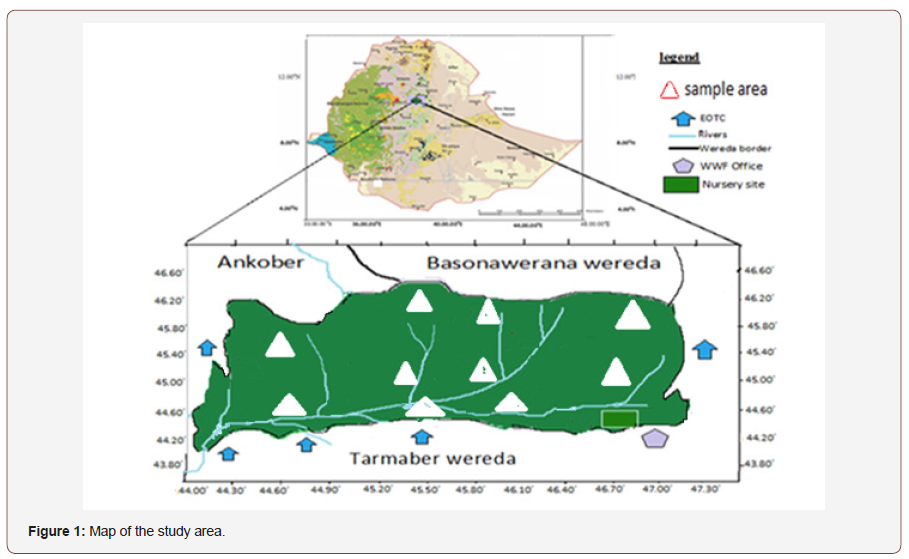
Sample collection
Soil samples were collected in a sterile polyethylene container at the depth of 15 cm pH 4.8 temperatures 25° C which was measured at the site of sampling area by using centimeter, pH meter and thermometer respectively. The sampling technique were selected randomly from the Northern, Southern, Eastern, Western and Central part of the forest from ten sample area at 2 km intervals and brought to the laboratory for further processing.
Isolation of fungi from soil sample
Fungal colonies were isolated by diluting 10 gm of soil samples in 100 ml of sterile distilled water by serial dilution method. Potato dextrose agar (PDA) (Potato 200 gm, Dextrose 20 gm, Agar 20 gm, Distilled water 1000 ml) media was prepared, autoclaved and poured in sterile Petri plates and 0.1 ml of soil samples were diluted up to 10-5 dilutions and spread on respective solidified PDA plates. The inoculated plates were incubated at ambient temperature for 120 hours (5 days).
Fungal isolates were differentiated on the basis of their physical characteristics such as hyphae and mycelium, which was obtained after incubation. Successive purification was carried out on sterile PDA plates by point inoculation and incubated by following the above method until pure isolate was obtained. Pure isolates were stored at 4° C using slants for further work [9].
Screening of fungal isolates for amylase production
To select the best amylase producing strains 108 fungal isolates were grown in starch agar media comprising the following, in gmL 1; yeast extract 1.5, peptone 0.5, sodium chloride 1.5, starch 10, agar 15, and make the media of the pH similar with pH of soil sample. The isolates were inoculated on sterile solidified starch agar plates a blank without inoculation was also maintained for comparison. Then the plates were incubated at room temperature for 120 hours after that all the plates along with blank was flooded with iodine and observed for zone of hydrolysis [10].
Inoculums preparation
Inoculums were prepared by adding 10 ml of sterilized distilled water into a sporulated 5 days old PDA slant culture. An inoculums needle was used to displace the spore clusters under sterilized conditions and then it was shaken thoroughly to prepare homogenized spore suspension [11].
Production of crude amylase using solid state fermentation
Solid state fermentation (SSF) medium was used for enzyme production from selected isolates using wheat bran as a sole carbon source supplemented with the following nutrients g/100 ml (%): glucose, 0.05; NH4SO4, 0.02; trisodium citrate, 0.027; MgSO4, 0.008; KH2PO4, 0.19 and 10g of wheat bran was moistened with above nutrient solution to a level of (v/w) 65% in 250 ml size Erlenmeyer flasks was used for cultivation of the fungal isolates. The moisture level of the wheat bran was removed after overnight oven drying at 105° C. To extract the released enzyme the moldy bran was soaked in 10 mM acetate buffer pH 4.8 in (w/v) 1:10 ratio [12], and shacked for 1hr at 120 rpm on the shaker, then the crude enzyme from SSF medium was harvested by centrifugation repeatedly at 5,000 rpm for 10 min [13].
Amylase assay
Enzyme assay was carried out based on the dinitro salicylic acid method [14]. As a substrate one gram of soluble starch was dissolved in 100 ml 50 mM acetate buffer pH 4.8 and gelatinized on a heater. Dinitro salicylic acid (DNSA) solution standard composition was prepared: g/l phenol 2; sodium sulfite 0.5; sodium potassium tartarate 200; Sodium Hydroxide (NaOH) 10; and Dinitro salicylic acid 10. To a 0.9 ml of the substrate 0.1 ml of enzyme source was added and incubated for 10 min at 50° C in water bath. At the end of the incubation period the reaction was stopped by adding 2 ml DNS solution. Enzyme source was added into a control after the reaction was stopped by the DNS solution. Then the reaction mixture was boiled for exactly 5 min in boiling water. Finally, the test tubes were cooled in running water for about 5min and the optical density (OD) of the resulting colored solution was measured at 540 nm against a blank.
Enzyme characterization
Identification of amylase type by sugar analysis on thin layer chromatography (TLC):To identify the type of amylase from the fungal isolates based on the starch hydrolysates TLC system [15-16] followed. First 0.9 ml 2% soluble starch mixed with 0.3ml crude enzyme from fungal sources was incubated for 30min at 50° C in the water bath. Then the hydrolysate was spotted on TLC plate along with standard known sugar (glucose, maltose and dextrose) solution. A one dimensional ascend was done by using a solvent system (v/v) of butanol: ethanol: water (5:3:2). After a total of five ascends air-dry TLC plates were sprayed with 50% (v/v) Methanol- H2SO4 heated for 10 min at about 100° C. The sugar spots appeared was identified by comparing with the standard known sugar.
Effect of pH on activity and stability of amylase: To determine the pH activity of the fungal amylases the crude enzyme was assayed using 1% soluble starch prepared in an acetate buffer systems pH 2.0 to 11.0. The activity of enzyme was determined by using the standard assay conditions [14].
Effect of temperature on activity and stability of amylase: To determine the effect of temperature on the activity of fungal amylase, the crude enzyme was mixed with starch soluble in 50 mM acetate buffer of pH 4.8 and incubated at temperatures of 20° C, 30° C, 40° C, 50° C, 60° C, 70° C, 80° C and 90° C for 10 min. Then the activity of amylase enzyme was determined by standard assay method Millern HP [13].
Effect of sodium ion concentration on amylase activity:To determine effect of metal ion on amylase activity the crude enzyme was mixed with different sodium ions concentration (0 M, 0.5 M, 1 M, 1.5 M, 2 M and 2.5 M) together with soluble starch in 50mM acetate buffer pH 4.8 and the activity of the enzyme was determined by standard assay method as mentioned above [17].
Effect of culture condition on enzyme production:Different incubation periods, moisture levels and carbon and nitrogens sources were used to determine the amount of amylase produced. Selection of appropriate carbon and nitrogen sources or other nutrients is one of the most significant stages in the development of an efficient and cost-effective process [18].
Effect of incubation periods on amylase production:To determine the time for maximum enzyme production the isolate was allowed to grow in solid state fermentation and the study was carried out at different incubation periods such as 24, 48, 72, 96, 120 and 144 hrs, after which amylase production was determined by standard assay method [19].
Effect of moisture levels on amylase production:The optimum moisture level for enzyme production was determined by growing the isolates at 28° C in the SSF media at a moisture level (v/w) of 45%, 55%, 65%, 75% and 85%). The enzyme was harvested, and its activity was determined by standard assay method [20].
Effect of carbon sources on amylase production:The effect of carbon source on growth and enzyme production by the isolate was determined by growing the test organism in SSF medium (by the method mentioned earlier) in which 0.5% of either of the following carbon sources: glucose, sucrose, lactose, fructose, starch and wheat flour were used as a sole carbon source. After harvesting the enzyme standard assay was carried on to determine effect of carbon sources on enzyme production. One unit of enzyme activity was defined as the number of micromoles of reducing sugar produced per minute in the reaction condition.
Effect of nitrogen sources on amylase production:To determine the appropriate nitrogen source for amylase production by the isolate, the test organism was cultivated in SSF medium (by the method mentioned in section 3.6) in which 0.2% (w/v) of either of the following nitrogen sources: NH4Cl, NH4NO3, (NH4)2SO4, peptone, tryptone, and urea used as a sole nitrogen source. Then the crude enzyme was harvested and assayed to determine effect of nitrogen sources on amylase production.
Results and Discussions
Isolation and screening of amylolytic fungi
Screening of fungal isolates for amylase production was done by starch hydrolysis test and the result indicated that 25% (27) of them are positive for amylase production. Further screening of these isolates which had relatively wider clear zone around the colony resulted in the selection of nine best isolates of amylase producing strains.
To select the best amylase producing fungi all the nine amylolytic isolates which had relatively wider clear zone were grown in liquid medium and the level of amylase activity was determined from the cell free culture supernatant. A total of 3 isolates that produced appreciable amylase activities in liquid culture were selected on the bases of the area of clearance and OD results of supernatant. Then, the best enzyme producer was selected for further studies on amylase production [21]. Due to maximum relative activity of enzyme in temperature and pH (Tables 1 and 2) and the formation of wider clear zone as compared to the other, isolate 46 was selected for further study.
Table 1: Effect of temperature on the activity of Amylase for three selected fungal isolates..

Table 1: Effect of pH on the activity of Amylase for three selected fungal isolates..

Morphological characterization of the isolate
The fungal isolate used in this study had a macroscopic feature on petri dish containing PDA media showed rapid growth; dark green color with yellowish border and the colony have granular powdery appearance. The back side of the colony was pale yellow in color and microscopic feature showed septate hyphae and conidiophore was attached to the septate. Based on these morphological features this isolate was tentatively grouped under the genus Penicillium [22].
Identification of amylase type by TLC
The amylase that was produced from the selected fungal isolate (WWFI 46) allows producing starch hydrolysates and running on TLC plate along with glucose, dextrose and maltose standard solutions. The fungal amylase mainly developed spot that was parallel with the standard glucose showed that the test enzyme was glucoamylase. This was direct evidence for the presence of glucoamylase in the fungal extract that resulted in the hydrolysis of starch to glucose. A similar analysis was reported elsewhere [23].
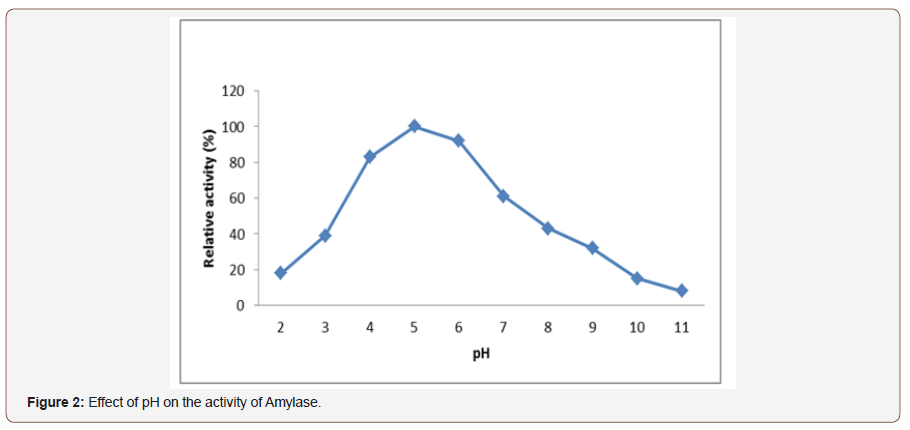
Effect of pH on activity of amylase:To determine the effect of pH on the activity of the glucoamylase enzyme incubated in a pH range 2.0 to 11.0 (at one interval). In this study as the pH value increase amylase activity also increases and its highest activity was observed at pH 5.0. The maximum amylase activity was found at pH 5 (Figure 2). Further increase in the pH resulted decrease in the activity of amylase. Different organisms have different pH optima and decrease or increase in pH on either side of the optimum value results in poor microbial growth, the decreased activity in the later phase of growth was probably due to catabolic repression by glucose released from starch hydrolysis. Similarly, [24] reported that fungal amylase could be denatured at high pH value.
Effect of pH on stability of amylase:The production of amylase in the fermentation medium affected by different pH value and have very essential role in the synthesis, secretion and stability of amylase [25]. After 1hr of incubation pH stability of fungal amylase was evaluated by assaying the enzyme and showed broad stability to pH range of 4.0 to 7.0 in which the enzyme retained a residual activity of at least 83% (Figure 3). This may be taken as an advantage for enzymatic liquefaction of starch industrially at moderately acidic condition (pH around 5). As a result, it can avoid problems that would pose undesired byproduct formation, high cost of product recovery in the downstream processing, and reduced amount of yield. It was also reported [26] that as pH value increased beyond 7.0, the enzyme stability showed a gradual decline due to the accumulation of hydroxyl ions.
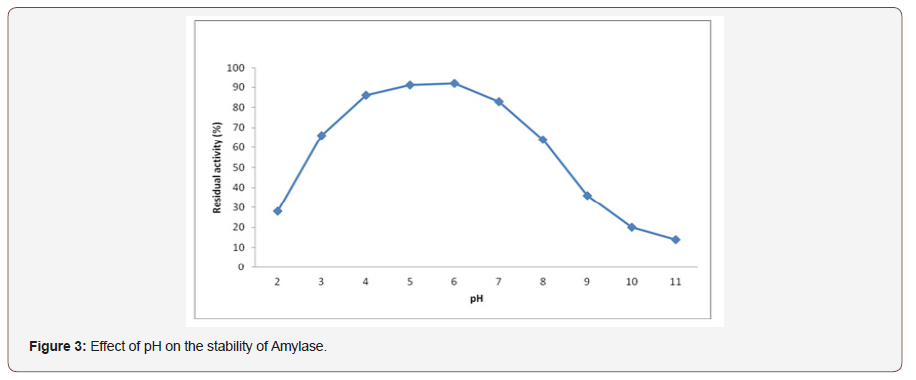
Effect of temperature on activity of amylase:The result showed that as temperature increases amylase activity also increase at a certain temperature. The highest relative activity of amylase was observed in a range of 40-600C and reached its maximum activity at 500C. There was a decrease in enzyme activity when the incubating temperature was further increased beyond the maximum and the least activity also observed at 900C (Figure 4). Temperature above 50°C result in moisture loss of the substrate, affect metabolic activities, reduction in growth and enzyme production of microorganism. As reported [27] that due to high temperature, the growth of the fungal isolate was greatly inhibited and hence, enzyme formation was also prohibited [28,29].
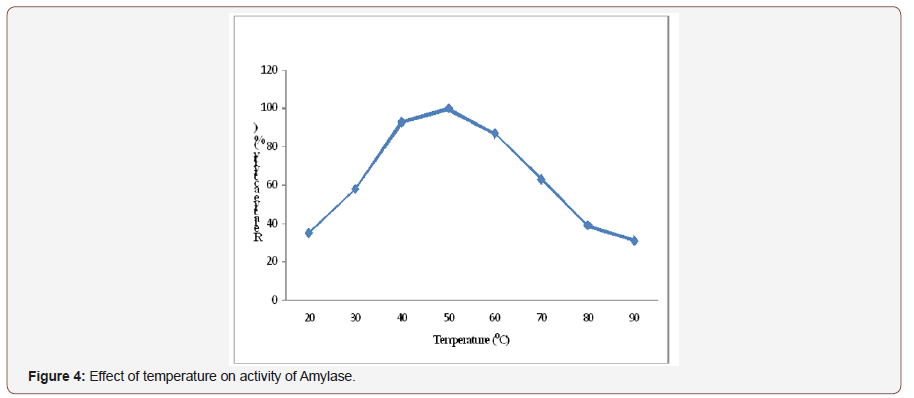
Effect of temperature on stability of amylase:Temperature stability of amylase was determined by incubating the enzyme at a range of (20-90° C) for 30min and followed the standard assay method of amylase. The result shows that amylase retained a residual activity of 96%, 91.8% and 85% related to incubation temperature of 20, 30 and 40 °C for 30 min respectively. It maintained more than 50% of its residual activity after it was incubated at temperatures below 60° C for 30min. It also maintained about 75% of its original residual activity at its maximum temperature of activity (50° C) after 30 min of incubation (Figure 5). The residual activity of this enzyme decreased with increase in incubation temperature. Furthermore, it was reported [30] that at high temperature, the stability of the enzyme was greatly affected and hence, enzyme production also reduced.

Effect of culture condition on amylase production
Effect of sodium ion (Na+) concentration on amylase activity:The enzyme activity in the presence of different sodium metal ions concentration was analyzed and it was found that the highest (100%) enzyme activities occurred in the absence of NaCl and subsequently decrease in their activity as the sodium ion concentration increases (Figure 6). Similarly, the activity of amylase was lost when NaCl concentration increased [31]. This might be the distraction of ion linkages due to the interaction of enzyme with sodium ion at the surface of their natural structure there by resulted in inhibiting and salting of the enzyme active site [32].
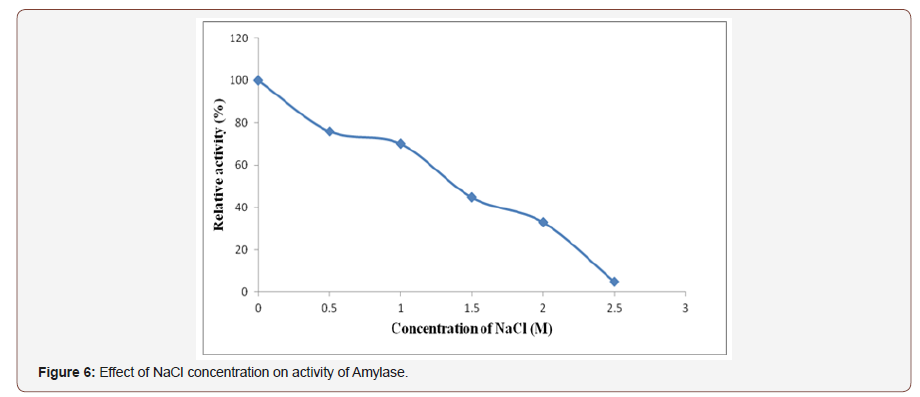
Effect of incubation period on amylase production:Fungal amylase from selected isolate was produced by using solid-sate fermentation at different time intervals ranging from 24, 48, 72, 96, 120 and 144 hrs incubation. As the incubation time increase amylase activity also increase and maximum amylase production was obtained at 72 hours of incubation. Beyond this period relative activity of enzyme was decreased (Figure 7). Time course study for the production of amylase governed by characteristics of the culture and also based on growth rate and enzyme production [33].
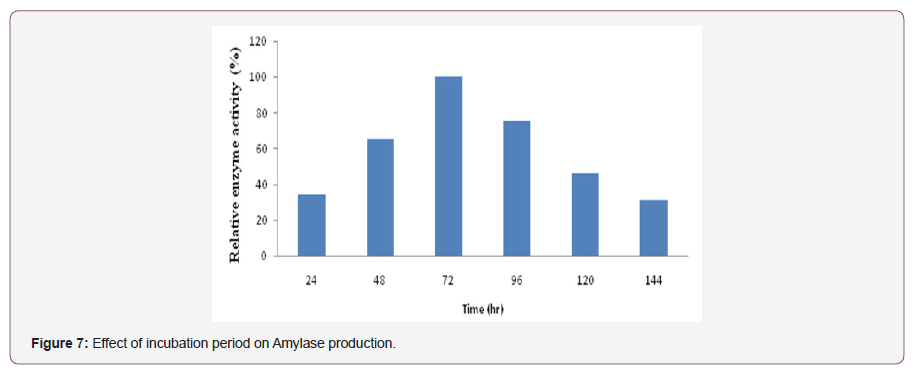
Enzyme secretion usually occurs maximally during the late exponential and early stationary phases. A prolonged incubation time beyond this period did not increase the enzyme yield rather decrease their secretion and reaches stationary phase and could have started producing secondary metabolites and lower yield of enzyme. The reason for this might have been due to the denaturation of the enzyme caused by the interaction with other components in the medium, deficiency of nutrients, accumulation of toxic substances and proteolysis of amylase as reported by many workers [34].
Effect of moisture level on production of amylase:Enzyme production was affected by the moisture content of the substrate that was grown in SSF. To determine the maximum enzyme production the selected fungal isolate was grown on wheat bran containing different moisture contents. The result indicates that the least amount of amylase was produced in wheat bran substrate at moisture content of 45% and the maximum amylase yield was observed at 65% of moisture content. Increase in moisture content beyond 65% leads to reduction in product yield (Figure 8). This is due to as moisture level increased anaerobic condition could be created, water molecules occupy the air space in the wheat bran, decreases porosity of solid state media, changes wheat bran particle structure, reduces gas volume, decreases diffusion and clumping of the solid particles resulted subsequent reduction in enzyme yield [35]. Generally, the higher moisture content leads to high catabolic repression because water activity increases rate of glucose diffusion. Low moisture content also reduces microbiological activity, solubility and better utilization of nutrients [36].
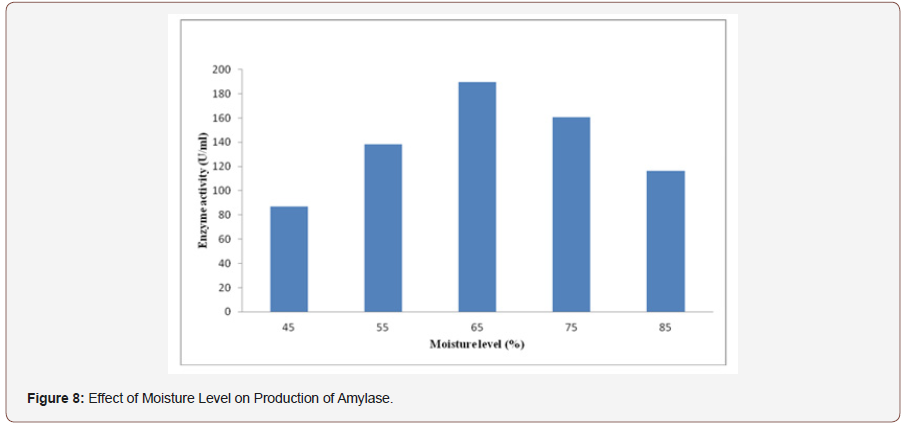
The production of enzyme is greatly dependent on the condition of growth of the culture and composition of nutrient medium [37,38]. In SSF, most of the microbial growth and product formation takes place at or near the surface of the solid substrate. Thus, it is very crucial to provide optimized water level that controls the water activity of the fermenting substrate for achieving maximum product [39].
Effect of carbon sources on amylase production:The nature and amount of carbon source in culture media is important energetic source for the production of extracellular amylase from fungal isolate (Figure 9). Therefore, production of amylase was tested by growing in SSF containing different carbon source as a substrate [40]. To determine amylase production supplementation of various carbon sources in growth media requires in the form of monosaccharide’s (Glucose and Fructose), disaccharides (Lactose and Sucrose) and polysaccharides (Starch and Wheat flour). Wheat flour was the best carbon source for amylase production whereas glucose results the least enzyme product and the other tested carbon sources gave comparatively less enzyme production, which is supplemented to the fermentation medium [41]. Therefore, soluble starch and wheat flour was optimized as a carbon source for further experimental work. Many other workers also reported wheat flour as the best carbon source for amylase production [42]. Different carbon sources have different influence on the production of extracellular enzymes [43].
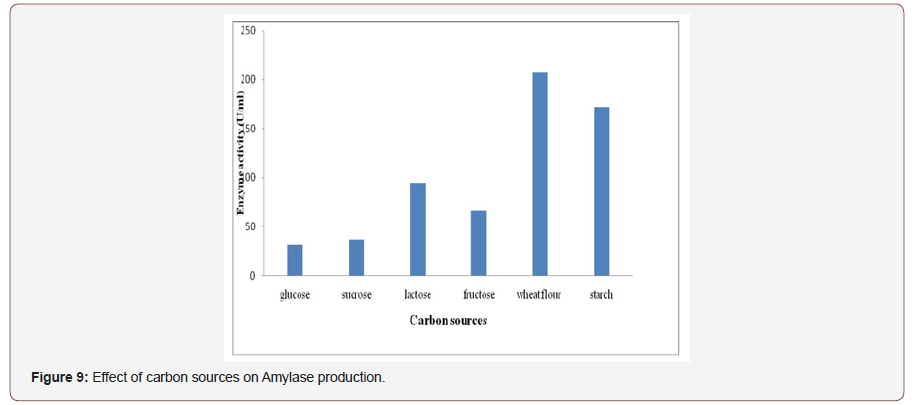
Effect of nitrogen sources on amylase production:Nitrogen is the secondary energy sources and plays an important role in the growth of the organism and enzyme production. The nature of the compound and the concentration that we used might stimulate or down reduce the production of enzymes. In this study the effect of supplementary organic nitrogen sources (Peptone, Tryptone, Urea) and inorganic nitrogen sources (NH4)2SO4, NH4NO3, NH4Cl) on the production of amylase by fungal strain using SSF was determined (Figure 10).
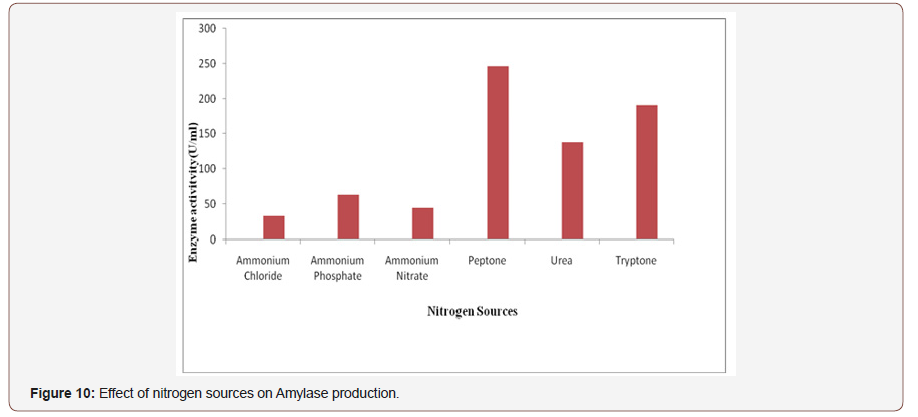
Among all the selected inorganic nitrogen sources maximum amylase production was obtained, when (NH4)2SO4 was added in the medium [44]. In case of organic nitrogen sources peptone was found the highest for amylase production, probably due to its high content in minerals, vitamins, coenzymes and nitrogen components [45]. Many workers reported that peptone as an organic nitrogen source produces maximum amylase. NH4NO3, NH4Cl and (NH4)4SO4 showed inhibitory effect on enzyme production. It might be due to the pH changes associated with their use in the medium [46].
Conclusion
The overall finding of the present study shows that it is possible to isolate amylase producing fungi from forest area like Wof Washa forest. Additionally, the isolated fungi strains were found to belong to penicillium genus, as these groups of fungi known to produce amylase. Maximum enzyme was produced from selected isolates using wheat bran as a sole carbon source which is easily available everywhere from agricultural waste within inexpensive cost. Enzyme produced from the isolated fungal strain had been stabilized with changes of temperature and pH on the activity and stability of amylase have taken as an advantage for enzymatic liquefaction of starch industrially at moderately acidic condition of pH around 5. The strain also showed maximum enzyme production in lower temperature ranges. This perhaps helps the strain not to be affected by evaporation and produce the enzyme without any need of incubator and humidifier. The strain grew in a short time of incubation. This is important to get the enzyme in very short time and thus reducing the cost of production and risk of contamination.
Amylolytic property of the enzyme helps to convert starch into smaller unit and value-added product for human and animal consumption. The enzyme is highly active at optimum temperature of 50° C and pH 5. It is also active in broad pH and temperature ranges. The enzyme is highly efficient for starch hydrolysis. All these properties infer that its suitable application in starch and starch product industry. The enzyme has a great potential for starch industry because of its amylolytic potential and environmentally friendly approach.
To read more about this article...Open access Journal of Biology & Life Sciences
Please follow the URL to access more information about this article
To know more about our Journals...Iris Publishers





No comments:
Post a Comment